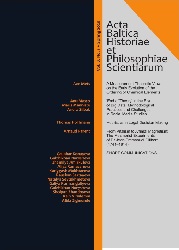From Vitalism to Animal Magnetism: The Mesmerist Experiments of Dr Jean-Emmanuel Gilibert (1741–1814)
From Vitalism to Animal Magnetism: The Mesmerist Experiments of Dr Jean-Emmanuel Gilibert (1741–1814)
Author(s): Arnaud ParentSubject(s): Metaphysics, Early Modern Philosophy, Philosophy of Science, 18th Century
Published by: Tallinna Tehnikaülikooli õiguse instituut
Keywords: 18th century; experimentations; Jean-Emmanuel Gilibert; mesmerism; vitalism;
Summary/Abstract: In 1766, the German physician Franz Anton Mesmer (1734–1815) presented at the faculty of medicine in Vienna his doctoral thesis On the Influence of the Planets on the Human Body (De planetarum influxu in corpus humanum), which was inspired by the De imperio solis ac lunae (1704), a work by Richard Mead (1673–1754), a disciple of Newton. In the thesis, Mesmer asserted that the cosmos and bodies floated in a universal fluid, which he called ‘animal magnetism’. Diseases resulted from disorders of animal magnetism within individuals, and he proposed brand-new treatments to cure these disorders. Around 1775, Mesmer sent his small monograph to different academies of science in Europe and to selected scientists. Only the Berlin Academy answered, but dismissed his work. In February 1778, he arrived in Paris, where he began to cure patients. A French physician from Lyon, Dr Jean-Emmanuel Gilibert (1741–1814), started to show interest in this mesmerist doctrine. Gilibert was a renowned physician and botanist. In 1775, he went to the Grand Duchy of Lithuania where he founded a medical school and a hospital in the town of Grodno (in present-day Belarus), where he worked from 1775 until 1781. He then moved to Vilnius to teach natural history at the Principal School of the Grand Duchy of Lithuania (Schola Princeps Magni Ducatus Lithuaniae, today Vilnius University), before returning to France in 1783. Gilibert was a strong believer in vitalism, a medical doctrine which stated that the physician should intervene as little as possible in healing the sick and letting nature do the healing. He saw animal magnetism as an expression of vitalism and carried out numerous experiments, which he described in letters addressed to his friend Antoine-François Prost de Royer (1729–1784). In 1784, Gilibert published these letters in his Outline on Animal Magnetism, or findings of the observations made in Lyon about this new agent (Apperçu sur le magnétisme animal, ou résultat des observations faites à Lyon sur ce nouvel agent). These letters are of utmost interest because they show how a scientist of the last quarter of the 18th century regarded science and scientific research, at a time when science and pseudoscience were still intermingled. This article will present the way in which Gilibert devised and carried out his mesmerist experiments, and the conclusions he reached.
Journal: Acta Baltica Historiae et Philosophiae Scientiarum
- Issue Year: 8/2020
- Issue No: 1
- Page Range: 72-95
- Page Count: 24
- Language: English

